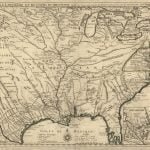
In 1718 Guillaume de L’Isle published “Carte de la Louisiane” which was based on the 1703 maps “Carte de Mexique et de la Floride” and “Carte du Canada ou de la Nouvelle France,” credited to him, but actually done by his father, Claude. The 1703 maps were based on the explorations of Marquette, Joliet, La Salle, LeSueur, and others. These maps depicted the Missouri River extending as far as the country of the Omaha Indians, the “Rivière Longue” of Lahontan, the full course of the Mississippi River and, for the first time, an accurate representation of the mouth of the Mississippi River and its delta.
The 1718 map shows an improved “Missouri R.,” which de L’Isle also labels “R. de Pekitanoni,” after Marquette’s name for the river. This map, however, does not include the excellent detail of the lower Missouri shown in another untitled map by Guillaume de L’Isle, also published in 1718, which was based on the 1714 explorations of Bourgmont. Nonetheless, “Carte de la Louisiane” does incorporate other information from Bourgmont and also from Father Jakob Le Maire and Sieur Vermale. De L’Isle’s map represents a tributary of the Missouri very close to the course of the Rio Grande (“Rio del Norte”). An extension of the upper Missouri–“Riv. Large”–runs to the west and around the northern edge of a chain of mountains; this “Riv. Large” may have been based on Lahontan’s mythic Long River.
De L’Isle depicts a “Chemin des Voyageurs,” or trading route, from the Mississippi River to the lands of the Omaha Indians near the Missouri River. “Carte de la Louisiane” was the first printed map to show the supposed route of Hernando de Soto in 1539-40; in addition, it traces the routes of other exploration between the Mississippi and the Rio Grande in the late 1600s and early 1700s. This is also the first map to refer to a variant of the name Texas (“Mission de los Teijas”).
De L’Isle’s “Carte de la Louisiane” became the primary reference source for the lower Mississippi and lower Missouri river valleys and was used by other cartographers as late as 1797. This map is believed to be the oldest map consulted in the planning of the Lewis and Clark Expedition.
